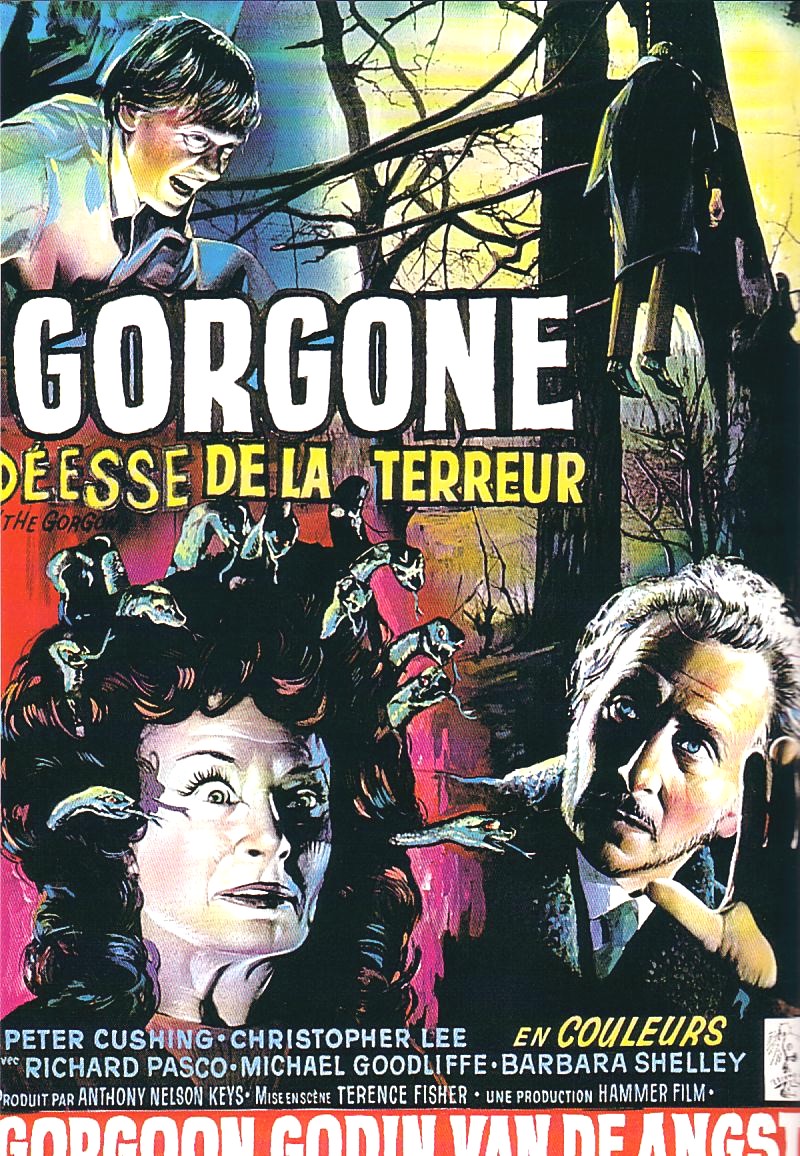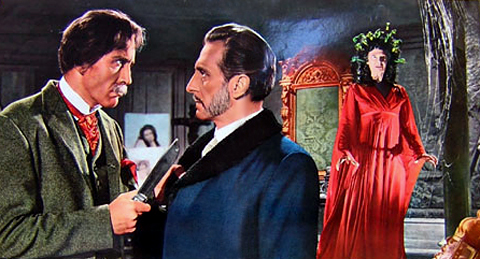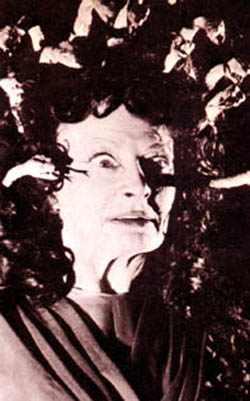 This is the last Hammer horror film to feature the studio’s essential triumvirate of director Terence Fisher and stars Christopher Lee and Peter Cushing. Made when the studio was looking for new ideas, but before it had begun its later decline, THE GORGON is an interesting addition to the company’s pantheon of classic monster movies – a sort of tragic love story told as a Gothic fairy tale. It features the company’s glossy production values, including colorful sets and beautiful photography, spiced with usual horrific chills (most memorably the petrified bodies of the Gorgon’s victims). Although never likely to rank alongside the seminal CURSE OF FRANKENSTEIN (1957) and HORROR OF DRACULA (1958), the film is a fine example of the form that deserves a place with Hammer’s other classics, such as CURSE OF THE WEREWOLF (1961) and THE PHANTOM OF THE OPERA (1962).
This is the last Hammer horror film to feature the studio’s essential triumvirate of director Terence Fisher and stars Christopher Lee and Peter Cushing. Made when the studio was looking for new ideas, but before it had begun its later decline, THE GORGON is an interesting addition to the company’s pantheon of classic monster movies – a sort of tragic love story told as a Gothic fairy tale. It features the company’s glossy production values, including colorful sets and beautiful photography, spiced with usual horrific chills (most memorably the petrified bodies of the Gorgon’s victims). Although never likely to rank alongside the seminal CURSE OF FRANKENSTEIN (1957) and HORROR OF DRACULA (1958), the film is a fine example of the form that deserves a place with Hammer’s other classics, such as CURSE OF THE WEREWOLF (1961) and THE PHANTOM OF THE OPERA (1962).
The story follows Paul (Richard Pasco), a young man who comes to an isolated village where the residents have been dying under mysterious circumstances, their bodies literally petrified. After a close encounter and a fleeting glimpse of a horrifying figure in the shadows, Paul is stricken, though not fatally. His university professor, Karl Meister (Christopher Lee) shows up to lend assistance and soon deduces that Dr. Namaroff (Peter Cushing) is concealing the identity of the Gorgon. Unfortunately for Paul, the monster turns out to be Namaroff’s assistant, Carla Hoffman (Barbara Shelley, previously seen in 1957’s CAT GIRL), with whom Paul has fallen in love. Although normal during daylight hours, Carla is possessed by an ancient spirit that, werewolf-like, turns her into a monster during the full moon. The next time the moon rises, Paul, Professor Meister, and Dr. Namaroff converge on the abandoned castle, where the Gorgon is known to lurk, for a final, fatal confrontation…
Scripted by John Gilling (who would go on to write and/or direct THE REPTILE and PLAGUE OF THE ZOMBIES), THE GORGON is an imaginative attempt to take the famous creature from Greek mythology and turn it into a viable movie monster by lifting bits and pieces of lore from other creatures of the night, most notably the werewolf. Consequently, the film has an almost achingly fatalistic tone, with an innocent individual cursed to do evil against her will, whose only hope for salvation lies in her own death.
This sets THE GORGON apart from Hammer’s earlier Frankenstein and Dracula titles, which often evinced the aesthetic of robust action film: colorful, dynamic, exciting. THE GORGON is more stately and sad. The narrative is in no hurry to string shock scenes together, and the suspense is minimal, restricted to a few key points. Instead, the film’s goal is, clearly, to work on an emotional level by emphasizing the doomed romance. The result may not jerk quite as many tears as the ending of TITANIC, but it works on its own level quite well.
As one would expect from a Hammer production, the sets, costumes, and photography all combine to create a wonderfully atmospheric version of a haunted European landscape, which belongs more properly to the realm of imagination that reality. The period detail may or may not be correct, but it does not matter: the film takes place in that same self-contained universe that is home to all Hammer horrors.
Horror stars Lee and Cushing also do expert work. As was usually the case, their combined efforts create a wonderful sort of chemistry that is more than the sum of its parts, making them the greatest duo in the history of the horror genre. The script even contrives to play a little game with audience expectations, delaying the inevitable confrontation between the two stars until viewers have just about given up hope — and then springing it on them after it seemed that it would not be happening after all.

Cushing delivers another variation on his Frankenstein persona, a doctor who runs an asylum and serves as a cornoer, but his villainy is more ambiguous. Clearly, he is covering up the truth, but he appears to be doing out of concern, even love, for Carla. For all his cold-heared precision, he ultimately succumbs to his emotions, risking his life to confront Carla in her Gorgon form – and failing because he cannot resist the urge to gaze upon her face.
Lee gets a rare opportunity to shine in a heroic role as the gruff, sarcastic Meister, taking the attributes he usually used to invoke fear (e.g., his imposing stature) and turning them to the side of the angels. The actor has a wonderful moment when Meister warns the local constable (Patrick Troughton) that the townsfolk had better not try to run him out of town (as they did his predecessor). Coming from anyone else, the line would sound like an empty threat (is Meister saying he will take on an entire mob, single-handed?), but Lee’s delivery imbues the words with conviction. (You’re almost sorry he never gets to make good on his threat.)
Barbara Shelly is excellent in the title role. Although not as glamorous as some of Hammer’s other leading ladies, she was perhaps the finest actress, and it is sad that she never became a bigger star in the genre despite her many good performances in a variety of roles ranging from RASPUTIN THE MAD MONK to QUATERMASS AND THE PIT (a.k.a. FIVE MILLION YEARS TO EARTH). Here, as in DRACULA, PRINCE OF DARKNESS and CAT GIRL, she deftly handles a schizoid role, half love interest and half monster.
 The briefly glimpsed Gorgon makeup is quite good in terms of its frightening look, especially when Fisher keeps it in shadows. Unfortunately, the special effects component, which brings the serpents to life, is slightly disappointing: the movements of the snakes writhing in the Gorgon’s hair have a mechanical quality that undermines the effect. Although Barbara Shelley wanted to play the character beneath the makeup, the producers were afraid that audiences would recognize her early on, giving away the surprise that Carla is the Gorgon; consequently, actress Prudence Hyman played the title character.
The briefly glimpsed Gorgon makeup is quite good in terms of its frightening look, especially when Fisher keeps it in shadows. Unfortunately, the special effects component, which brings the serpents to life, is slightly disappointing: the movements of the snakes writhing in the Gorgon’s hair have a mechanical quality that undermines the effect. Although Barbara Shelley wanted to play the character beneath the makeup, the producers were afraid that audiences would recognize her early on, giving away the surprise that Carla is the Gorgon; consequently, actress Prudence Hyman played the title character.
As a pure horror film, THE GORGON may be a disappointment. The fear-factor is not up to the levels of Hammer’s highest efforts, and the scares tend to be low-key, lacking the action-packed punch of, for example, HORROR OF DRACULA. Instead of a bloodthirsty Count leaping over a table and hurling his vampire mistress to the floor, you get a snake-headed woman lurking the shadows and staring at her victims — a sort of static tableau that does not necessarily set adrenalin coursing through the veins.
But then, Terence Fisher was never a pure horror director. In the definitive career interview he gave to Cinefantastique magazine in the early 1970s, he expressed less interest in the mechanics of suspense, as exemplified by Alfred Hitchcock, than in the melodramatics of Frank Borzage. Fisher always wanted to make a love story, and here he gets his chance — albeit a doomed love story. The emotional underpinnings raise THE GORGON to the level of a genre gem, even if you are more likely to cry than scream.
THE GORGON (1964). Directed by Terence Fisher. Written by John Gilling, story by J. Llewellyn Devine. Cast: Christopher Lee, Peter Cushing, Richard Pasco, Barbara Shelley, Michael Goodliffe, Patrick Troughton, Jack Watson.
RELATED ARTICLES:
- Review: Curse of Frankenstein
- Review: Cat Girl
One Reply to “The Gorgon (1964) – Horror Film Review”